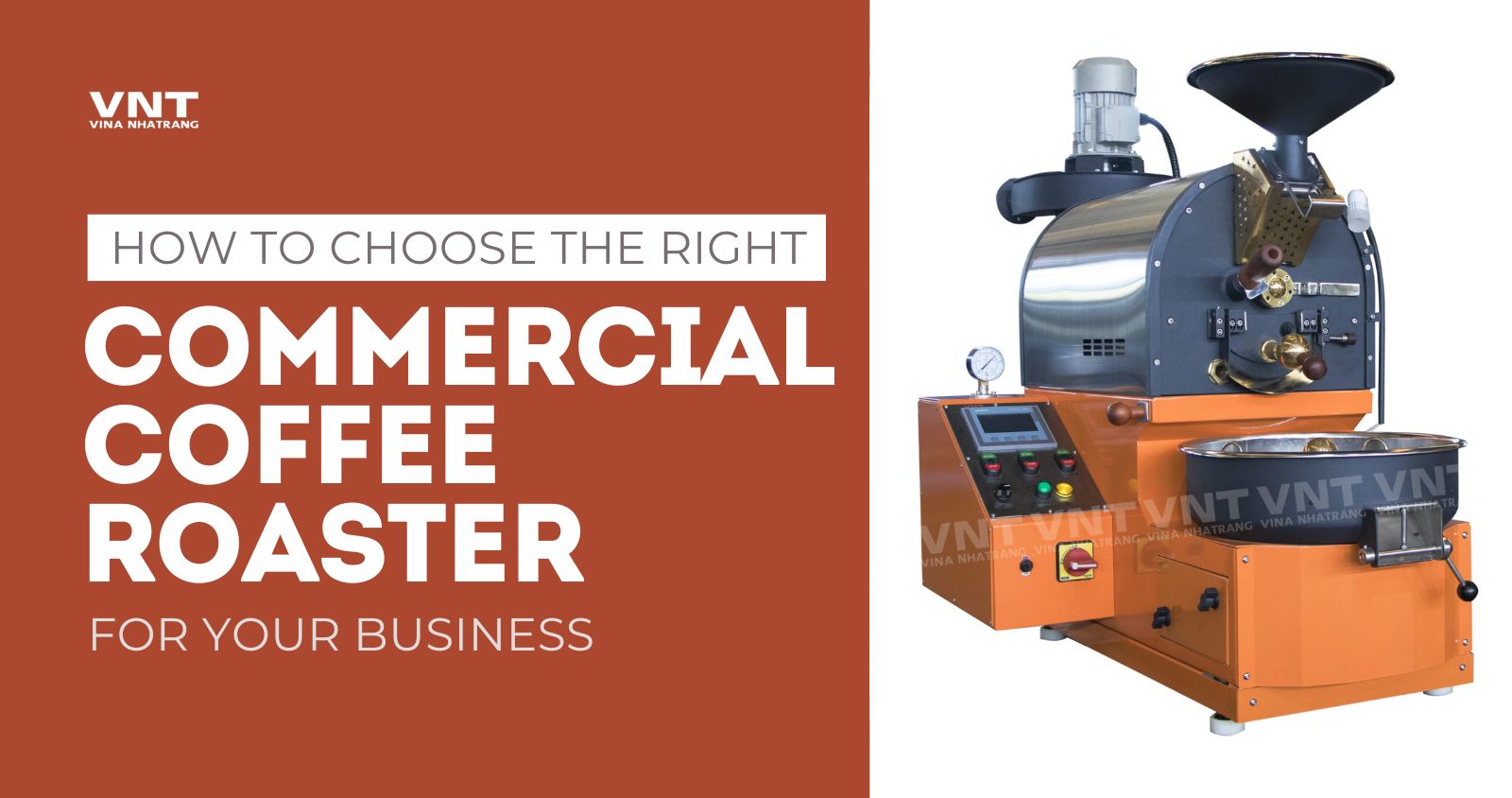In the competitive world of large-scale coffee production, choosing the right commercial coffee roaster is a critical decision that can significantly impact product quality, consistency, and operational efficiency. With a vast array of options available in the market, it’s essential to carefully evaluate your roasting needs, production requirements, and long-term goals to ensure you select the most suitable commercial coffee roaster for your large-scale operation.
1. Understanding Your Roasting Needs
The first step in choosing the right commercial coffee roaster is to thoroughly understand your roasting needs. Begin by assessing your current and projected production capacity and volume requirements. Determine the desired batch sizes and roast profiles that align with your product offerings and target markets. Consider the types of coffee beans you plan to roast, as well as the desired roast levels, from light to dark.
Evaluate the available resources within your facility, including the available space, energy sources, and ventilation systems. These factors will play a crucial role in determining the feasibility and operational costs associated with different types of commercial coffee roasters.
Share your needs with our experts for personalized commercial coffee roaster guidance.
2. Types of Commercial Coffee Roasters
When it comes to commercial coffee roasters, there are three main types to consider – drum roasters, fluid bed roasters, and centrifugal roasters. Each variety offers distinct advantages and disadvantages, making it crucial to understand their respective strengths and limitations to determine the best fit for your large-scale operation.
Drum Roasters:
Drum roasters are a popular choice for their consistent roasting performance and high-capacity capabilities. These roasters utilize a rotating drum to evenly expose the coffee beans to heat, ensuring a uniform roast.
However, drum roasters tend to be more energy-intensive and may require more complex maintenance procedures compared to other types.
Fluid Bed Roasters:
Fluid bed roasters are renowned for their energy efficiency and even roasting. These roasters utilize a bed of hot air or an inert gas to roast the coffee beans, resulting in a consistent and even roast.
However, fluid bed roasters generally have lower capacity limits compared to drum roasters, and there is a potential for scorching if not properly monitored.
Centrifugal Roasters:
Centrifugal roasters offer the advantage of rapid roasting times and versatility, capable of handling various batch sizes and roast profiles. These roasters use centrifugal force to continuously agitate the coffee beans, ensuring even heat exposure.
However, centrifugal roasters often require a higher level of skill and expertise to operate effectively, and there is a risk of uneven roasting if not carefully monitored.
3. Key Features to Consider
When evaluating commercial coffee roasters for your large-scale operation, it’s essential to consider several key features that will directly impact your operational efficiency, product quality, and overall profitability. Here are some critical factors to assess:
-
Roasting Capacity and Throughput: Ensure the roaster has the capacity to handle your current and projected production volumes seamlessly. A roaster with inadequate capacity could bottleneck your operations, while an oversized roaster could lead to inefficient use of resources and higher operational costs.
-
Roast Profiling and Control Systems: Prioritize commercial roasters equipped with advanced profiling and control systems that allow precise monitoring and adjustment of roast parameters such as temperature, airflow, and time. These systems enable you to achieve consistent and repeatable roast profiles, ensuring your coffee meets the highest quality standards.
-
Energy Efficiency and Fuel Options: In large-scale operations, energy consumption can significantly impact your operational costs. Evaluate roasters that offer energy-efficient designs and flexible fuel options, such as gas or electric, to minimize your carbon footprint and maximize cost savings.
-
Automation and Monitoring Capabilities: Automated features and real-time monitoring systems can significantly improve consistency and reduce labor requirements, ultimately increasing operational efficiency. Look for roasters with advanced automation and monitoring capabilities that can streamline your production processes.
-
Ease of Operation and Maintenance: User-friendly interfaces and straightforward maintenance procedures are crucial for ensuring smooth operations and minimizing downtime. Prioritize roasters designed with operator convenience in mind, offering intuitive controls and easy access for maintenance tasks.
-
Quality Control and Consistency: Consistent roast quality across batches is paramount in large-scale operations. Evaluate the roaster’s ability to deliver uniform roasting results, ensuring your coffee meets the highest standards of quality and flavor profile every time.
-
Integration with Existing Systems: If you have existing production processes and systems in place, it’s essential to ensure that the new commercial coffee roaster can seamlessly integrate with them. Seamless integration can streamline your operations, minimize disruptions, and maximize overall efficiency.
| Capacity | 90 – 120kg/hr, 20 – 30kg/batch |
|---|---|
| Gas consumption | 2.5 – 3.5kg of gas/100kg of coffee beans |
| Electricity consumption | 4.85KWh |
| Power supply | 3 phase – 50Hz |
| Dimension (LxWxH) | 3600 x 2200 x 2500 (mm) |
| Approx. weight | 1600kg |
4. Factors Affecting Your Choice
When selecting an commercial coffee roaster for your large-scale operation, it’s crucial to consider several external factors that extend beyond the roaster’s technical specifications. These factors can significantly impact the roaster’s suitability, operational efficiency, and long-term profitability within your specific business context. Here are some key external considerations to keep in mind:
-
Production Volume and Growth Projections: Invest in an commercial roaster that not only meets your current production demands but also accommodates your anticipated growth trajectories. Ensure that the roaster’s capacity can scale seamlessly as your business expands, avoiding the need for premature upgrades or capacity constraints that could hinder your future growth.
-
Available Space and Infrastructure: Thoroughly evaluate the roaster’s physical footprint and infrastructure requirements, such as ventilation, electrical, and utility needs. Ensure that your facility can accommodate the roaster’s dimensions and meet its operational requirements without the need for costly renovations or infrastructure overhauls.
-
Environmental Regulations and Certifications: In today’s environmentally conscious market, it’s essential to ensure that your commercial coffee roaster complies with all relevant local and industry-specific environmental regulations and certifications. This not only demonstrates your commitment to sustainability but also mitigates potential legal and reputational risks.
-
Energy Cost and Sustainability Goals: Energy consumption can significantly impact your operational costs and carbon footprint. Factor in the roaster’s energy requirements and align your choice with your organization’s sustainability goals and initiatives. Prioritize energy-efficient models that can minimize your environmental impact and reduce long-term energy costs.
-
Skilled Labor and Training Requirements: Different commercial roasters may have varying levels of operational complexity and maintenance requirements. Assess the training needs for your staff to operate and maintain the roaster effectively, and ensure that you have access to skilled labor or can provide adequate training to your existing workforce.
-
Integration with Existing Processes: Carefully evaluate how the new commercial roaster will integrate with your existing production workflows and processes. Seamless integration can streamline operations, minimize disruptions, and maximize efficiency, while incompatibility could lead to costly process overhauls or inefficiencies.
-
Budget and Return on Investment (ROI): While investing in a high-quality commercial roaster is essential, it’s crucial to carefully evaluate the upfront costs, ongoing operational expenses, and potential return on investment (ROI) for each option. Strike a balance between short-term capital expenditures and long-term profitability, ensuring that your investment aligns with your overall business objectives and financial goals.
Vina Nha Trang Engineering JSC has recieved multiple prestigious awards and certificates for exceeding in these factors for our machines. Explore our Awards and Certifications
5. Sourcing and Purchasing Considerations
After carefully evaluating your large-scale operation’s needs and identifying the ideal commercial coffee roaster, the next step is to navigate the sourcing and purchasing process. This phase is crucial in ensuring a smooth transition and long-term success with your new roasting system. Here are some key considerations to keep in mind:
-
Reputable Manufacturers and Suppliers: Partner with established and reputable manufacturers and suppliers that have a proven track record in the coffee roasting industry. These trusted partners not only offer high-quality equipment but also provide valuable expertise, guidance, and support throughout the purchasing and implementation process.
-
Custom or Pre-engineered Solutions: Determine whether a custom-designed roaster tailored to your specific requirements or a pre-engineered, off-the-shelf solution better aligns with your needs and budget. Custom solutions offer unparalleled flexibility and optimization but may come at a higher cost, while pre-engineered roasters can be more cost-effective while still meeting most operational requirements.
-
Installation and Training Services: Inquire about professional installation services offered by the manufacturer or supplier. Proper installation is crucial for ensuring optimal performance and longevity of your commercial roaster. Additionally, invest in comprehensive training programs for your staff, enabling them to operate and maintain the roaster effectively from day one.
-
Warranty and After-sales Support: Evaluate the manufacturer’s warranty coverage and after-sales support offerings. A robust warranty provides peace of mind and protects your investment, while reliable after-sales support ensures prompt assistance with maintenance, repairs, and troubleshooting, minimizing downtime and maximizing operational efficiency.
-
Financing Options and Leasing Agreements: Explore flexible financing options, such as leasing agreements or equipment loans, to manage the upfront costs associated with purchasing an commercial coffee roaster. These financing alternatives can help preserve your working capital while allowing you to acquire the necessary equipment to support your large-scale operation’s growth.
Interested in learning how cost-effective incorporating Vina Nha Trang Engineering JSC’s Commercial Coffee Roaster into your plant? Request a consultation today
Conclusion:
Choosing the right commercial coffee roaster for your large-scale operation is a decision that requires careful consideration of your roasting needs, production requirements, and long-term goals. By understanding the different types of roasters, evaluating key features, and accounting for factors such as production volume, space constraints, and environmental regulations, you can make an informed choice that ensures consistent quality, efficient operations, and a competitive edge in the market.
Remember, investing in the right commercial coffee roaster is an investment in the future success of your large-scale coffee operation. Don’t hesitate to consult with industry experts, conduct thorough research, and explore various options before making your final decision. With the right commercial coffee roaster in place, you’ll be well-equipped to produce exceptional roasted coffee that captivates the palates of discerning consumers worldwide.






